Well, these came in on December 31, 2010 just in time for me to have a day off and play with these new toys. There is a lot to like about the new Pocket Wizard FlexTT5 transceivers and a couple of disappointments, but in the very short time that I have had a chance to play with them, I've been both pleased and disappointed.
Here are a few shots of the freshly received units and the un-boxing ceremony:
Here are a few shots of the freshly received units and the un-boxing ceremony:

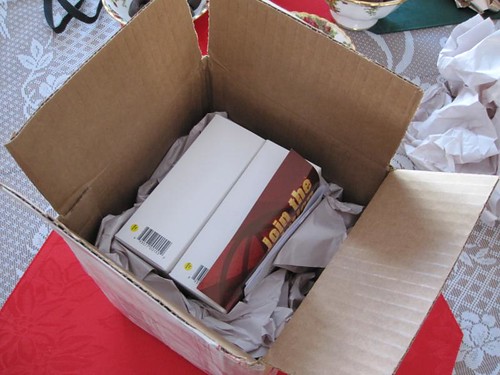
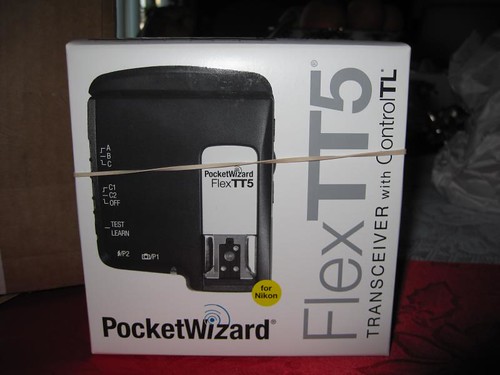

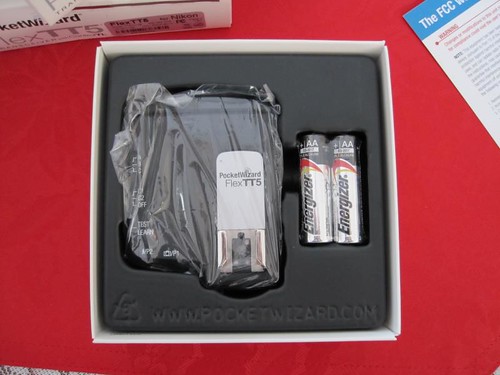
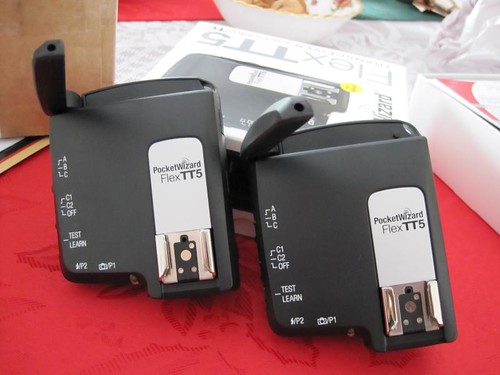

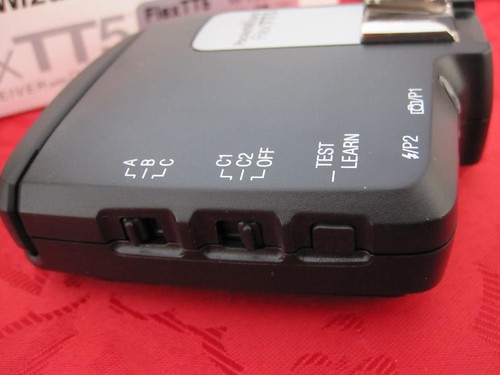
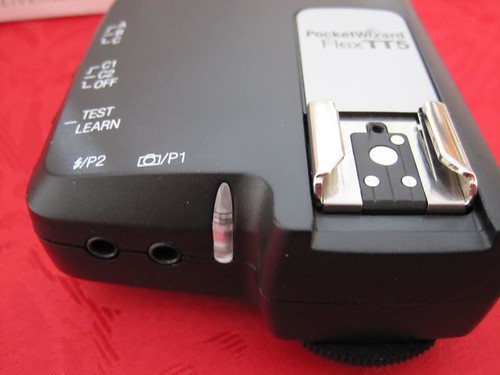
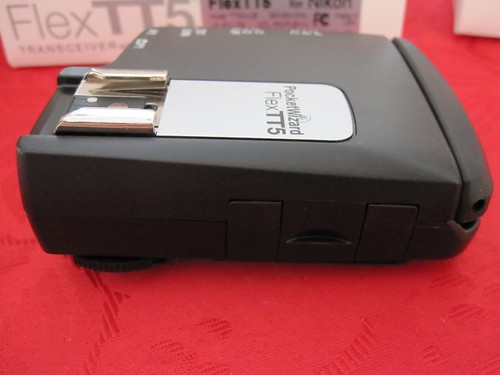
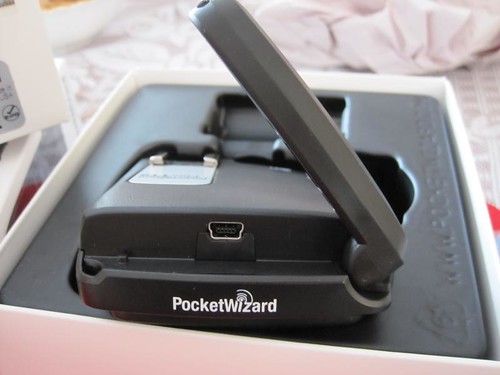
Pocket Wizards are traditionally well known as the distance kings in the remote camera flash department and are touted as having a range of over 1500 feet, and I have pushed 800 feet several times with the Plus II units and they never broke a sweat or given me a misfire.
These new units because there is so much more info being transmitted, (pre-flashes, TTL info, multiple groups, and so on...), receive an appropriate dropped rating of 800 feet. Other pros in the industry mention a 600 foot max distance.
Let me first drop the bomb... this is one of the areas that I was disappointed in. In line-of-sight testing, there is nowhere *near* 600 feet of range. I was hoping for about 300 reliable feet, and though I did manage to trigger it a few times from as far as 320 feet, it was with a lot of misfires and total unreliability. Before we get into the actual info, let's look at the setup.
We started with the following; A FlexTT5 underneath a Nikon SB-900 on a light stand and a calibrated Lufkin rolling distance measuring unit (distances measured in feet and inches). So what is the reliable range? Let's check it out:
These new units because there is so much more info being transmitted, (pre-flashes, TTL info, multiple groups, and so on...), receive an appropriate dropped rating of 800 feet. Other pros in the industry mention a 600 foot max distance.
Let me first drop the bomb... this is one of the areas that I was disappointed in. In line-of-sight testing, there is nowhere *near* 600 feet of range. I was hoping for about 300 reliable feet, and though I did manage to trigger it a few times from as far as 320 feet, it was with a lot of misfires and total unreliability. Before we get into the actual info, let's look at the setup.
We started with the following; A FlexTT5 underneath a Nikon SB-900 on a light stand and a calibrated Lufkin rolling distance measuring unit (distances measured in feet and inches). So what is the reliable range? Let's check it out:

... and start by doing a reset the distance meter to zero it out:

... then walked out to 50 feet, turned and tested successfully:


... walked out to 100 feet, turned and that fired successfully:


... walked up to 150 feet, turned and that fired successfully yet again:


... walked out to 200 feet, turned and fired and... nothing! I tried again, and after moving sideways some got a hit, but, it was far from reliable. So I tried from 190 feet... nothing again! Walked forward to 180 feet.. and...

 ... we got every test working well at 180 feet except the last two pops that failed, however, I *think* we were doing full power dumps and I may not have given the needed 3-4 seconds to recycle or it just did not give me 100% reliability at 180 feet (which I am pretty sure I waited more than enough between pops), but the point was made... the FlexTT5 units are nowhere near the distance champs and bullet-proof reliability of the Plus II units and they fall far short of their rated distances of 800 feet (or of the 600 ft mark as per what Rob Galbraith said they were able to do). I'd **love** to know what he did to be able to get 600 foot ranges, because that would mean that my 300 foot shots would be rock solid reliable and I could live with that.
... we got every test working well at 180 feet except the last two pops that failed, however, I *think* we were doing full power dumps and I may not have given the needed 3-4 seconds to recycle or it just did not give me 100% reliability at 180 feet (which I am pretty sure I waited more than enough between pops), but the point was made... the FlexTT5 units are nowhere near the distance champs and bullet-proof reliability of the Plus II units and they fall far short of their rated distances of 800 feet (or of the 600 ft mark as per what Rob Galbraith said they were able to do). I'd **love** to know what he did to be able to get 600 foot ranges, because that would mean that my 300 foot shots would be rock solid reliable and I could live with that.I am sorry to say that this did not come close to happening.
Ok, so they cannot trigger a flash from 65 miles away... so, what do I like about these units?
- iTTL functionality. You have to love it, and for me, being able to meter on fast moving and distance changing subjects and still get at least close to perfect exposures is important to me in wedding environments (this is single group iTTL, no in camera FEC and no manual power control. For those features you need a commander).
- HYPER-SYNC! Ok, its only 1/3rd of a stop more on FX bodies from 1/250th up to 1/320th on my D700, but I have already come across a couple situations and wished I had that 1/320th, but did not at the time. Now I do, and even when using a Nikon flash and a plus II receiver, I still get that fully lit frame at 1/320th... sweeeet!
- High-speed Focal Plane Flash sync speeds. Being able to sync specific Nikon flashes to shutter speeds up to 1/8000th is just awesome for those times you want to control ambient and shoot at wide open apertures. It adds *so much* control to your shots and is something that I see myself using often, matter of fact, any chance I can get, you bet I am going to use it!
- The ability to control the flash power from the camera (in either TTL or manual or mixed iTTL/manual environments at the same time), either via a heavy SB-800, SB-900 or SU-800... or via the as yet unreleased (as of January 1, 2011), Pocket Wizard AC-3... which will definitely be *my* preferred method. A huge flash on the camera adds way too much weight especially if you are like me and use something like a D700, battery grip and long lenses like a Nikkor 70-200. Adding that behemoth SB-900 to that recepie is a back breaker in a very short time, and honestly, the plastic foot of the FlexTT5 does not give me much confidence in the strength department (which if you think about it a moment is a *good* thing. Better to replace the foot of the Flex than replace a flash or need to send in the camera for repairs in the event you break something and the weakest denominator cracks).
However, that, my friends, is control!
No more need for me to run across the room, lower that 13-foot lightstand, adjust flash power, raise the flash back up again, it can all be done from anywhere I happen to be standing in the room via going no further than what is sitting in the hot shoe of my camera... whoo-hooo! :)
But I digress... I will make a separate post just for the AC-3 when it becomes available to us, and I am looking forward to it as much as I looked forward to receiving the actual FlexTT5 units themselves! (Edit: As of January 11, 2011, I am on the Beta team for the AC3, you can check out my posting on it HERE!)
- Squelched pre-flash communications, means faster transfer of data between flash and camera as well as reduced iTTL power usages thanks to the flash not needing to fire that communication signal. Also, no preflash in a manual power controlled setup is just plain sweet and means fewer blinkers, which was a very serious and huge deterrent in wanting to use TTL ever!
So, is there anything that I don't like?
Well, besides the very disappointing reliable triggering distances (I would have *loved * rock solid 300 foot performance), there were a few things that I was not pleased with.
- The PW firmware update utility software is for all intents UNUSABLE on my ASUS EEE netbook using it's native 1024X600 resolution, the software loads but does not show the full screens... in other words, no changes are accessible thanks to the clipped pages without scroll bars. Someone there forgot to integrate a SCROLL BAR into that application.
A bad programming move and should be relatively easy to avoid... c'mon LPA Designs software programmer, since I cannot change channels on the Flex/Mini units themselves, at least let me use the smallest laptop around to do so, and by that not force me to have a laptop with a minimum 1280X1024 screen just to be able to use the software to make important configuration changes like channel number changes, Hypersync modifications, and so on!
- The Nikon FP HSS hack that works so awesomely on the PW Plus II's does NOT work with the flex units when using 1 flex on camera and a Plus II is at the studio head (though it works great with 2 Plus II's). Using 2 Flex units it does work, however, it is nowhere near as efficient. (ADDENDUM February 23, 2011 - Sorry, we can take this one off the list. As of the last firmware, these things not only work 100% all the way to 1/8000th perfectly in an all ControlTL setup, but because they are adjustable, you can eek out MORE power than using the Plus II's!!)
With the Plus II units. While I lose about 2/3-1 stop from my Photogenic 2500DR studio head going from 1/250th to 1/500th with the Plus II units at both ends, when using the Flex units, I lose a good 2-2.5 stops... thats a TON of lost light for basically nothing.
So, thats it, that's my 2 cents and initial impressions on these new units after playing with them for only one day. However, I am working on something that will *possibly* get me a little extra increased triggering distance... I don't know for sure, and I am not saying what it is until I can test it out, so, stay tuned and check in on this site now and then to see what the results of my tests will be once I get in my secret "stuff" in.
I also have something that I want to do to increase those lighting situations where you need that little extra light in really bright conditions and still be able to sync at high shutter speeds.
I am being cryptic on purpose, but hey... thats how I roll... lol.
I'll leave you here with a few shots of my father (who is always up for helping me out, God bless him!), taken using a 135mm F/2 Nikkor lens on my D700 at higher shutter speeds.
The "Before Shot", no flash. 1/100th shutter speed, F/8, ISO 200 :

The "After Shot #1", 1/800th, F/3.2, ISO 200

The "After Shot #2", F/2.0, 1/2000th, ISO 200

Addendum - January 16, 2011:
I just wanted to add a couple of points that I feel will aid in the experience of using the FlexTT5 units.
- Before every session, make sure you are using freshly recharged batteries. It makes a difference, especially when distances start to get long.
- Make sure the group settings are set on the remote flash before you turn on the FlexTT5 of the remote flash.
- When turning on the units, do so in a "top to bottom" order. Start off with the remote flashes before the unit on the camera.
- Raise the antenna on ALL your FlexTT5 units, leave them up.
- If you are using the AC3, make sure it is in place before you turn on the FlexTT5 that is in the hot shoe of your camera. If using a flash, make sure it is in place before you turn on the Flex that is in the camera hot shoe.
- There is a lag time of several seconds before communications is established before first use. A little patience here helps. Once established, you should be good to go. To avoid this lag, leave the camera, and all FlexTT5 units turned ON in between moments that you are not shooting. If you change from one preset configuration to another, this lag time will come into play before things stabilize. You will know when the new configuration lag time is past when you press the Learn/Test button on the FlexTT5 unit on top of the camera and flashes fire properly.
- Be aware that the Test/Learn button will only fire the flashes that your AC3 settings permit. If you have all 3 groups turned off, no flash will fire. Placing a group in M or A will fire off all flashes in that group. Also, if your AC3 group is set to manual, pressing the Test/Learn button fires off the remote flash at the power setting that your AC3 is telling it to fire at.
If the setup is acting up, do the 10-second reset on all the flex and mini units, turn EVERYTHING off and turn on in the proper order:
Starting at the remote flashes:
- turn things on from a top down manner, meaning, the flash that is in the flex first, THEN the flex.
- Proceed to the other remote flashes before the camera
At the camera end make sure everything is turned off. Assuming you have a camera with a flex or mini in the camera hot shoe and a flash in the hot shoe of the flex or mini:
- turn on the flash
- turn on the flex or mini
- turn on the camera
Everything then should work nicely again, if not make sure all the antenna are up on all flex units.
CAUTION: When shooting TTL, the camera sets flash power. Make sure that you are not popping out continuous full power flashes! With SB-600/800 flashes you will likely damage them. With SB-700-900s you will push them into thermal overload and and they will likely shut down.
This is one of the main reasons I shoot in manual. Knowing what the flash is doing at all times is important.
-----------------------------------------------------------
Addendum - January 23, 2011:
The "audible beeps" that let the photographer know that the remote flash is recycled do not work on remote flashes controlled by the FlexTT5. This is because the PW Flex emulates the local camera environment to the remote flash and in the Nikon firmware, if a flash is on camera, it does not beep, even if the option is activated in the menuing system. LPA Designs is aware of this but I have no idea of if they will even be able to do anything about it.
Personally, I never used this feature much anyways... anything that takes power away from my batteries to power the flash is not really an obligatory feature for me. I shoot mostly in manual mode, know what power I am using and know how long to want for the flash to be able to recycle.
Personally, I never used this feature much anyways... anything that takes power away from my batteries to power the flash is not really an obligatory feature for me. I shoot mostly in manual mode, know what power I am using and know how long to want for the flash to be able to recycle.
-----------------------------------------------------------
Addendum - January 26, 2011:
Challenge:
Place a flash (like the SB-600 for example), in the hot shoe of the FlexTT5, set the power control of the flash to MANUAL instead of TTL and have it work.
Solution:
One cannot place a Nikon TTL flash in the hot shoe of the Flex and still use manual control settings via the flash. Doing so results in nothing but full power dumps from the flash, no matter what settings you set the flash to.
To regain on flash manual control, you must plug in a hot shoe adapter into the appropriate socket on the flex and this makes the flash into a "basic trigger mode only" flash and you can then regulate the power on the back of the flash.
Of course, the coming AC3 Zone Controller kinda trumps this and you will be able to control power manually on the SB-600 flash (and all other approved flashes) via the AC3 controller.
-----------------------------------------------------------
Addendum - January 26, 2011:
Challenge:
Use the PW Control TL Units in an environment as a professional photographer.
Solution:
The units worked well at my last session doing an engagement party. The location was very dark and maximum distances were under 50 feet. In all manual control, the flashes all worked, there were no misfires and the performance was rock solid. When using the key light on TTL or "Auto" mode, the exposures were inconsistent. I need to do further testing in this mode to see if the inconsistent results are reproduceable or random.
Results of the evening can be viewed here >> http://www.jerryph.com/?p=1047
-----------------------------------------------------------
Addendum - February 9, 2011:
I know... I said that I would not purchase a MiniTT1 because I wanted to stay all AA battery and have the advantage of possible additional distance by staying all FlexTT5s, but I caved and bought a MiniTT1 today.
First impressions are that it is smaller and convenient to have on camera, and no antenna to be in the way, and the AC3 fits a lot snugger and without movement than when placed in the FlexTT5 units. I need to find a cheap source for quality coin batteries and later on, maybe some chargers and rechargeable batteries for this unit if I can find some good quality batteries and chargers.
-----------------------------------------------------------
Addendum - February 12, 2011:
Challenge:
Use the D700 in camera AF assist light with the Mini/Flex.
Solution:
When the Mini/Flex is on the camera, the camera believes that there is a flash on it and disables the in camera AF assist light because it would be using the AF assist light from the flash (SB-800 SB-900 only, as far as I know).
If you absolutely need an AF assist light on the D700, you are going to need to use a flash on top of the Mini/Flex. This is not so bad, because the AF assist light from the flash is way more powerful, reaches further and is not obstructed the way the in camera AF assist light is by most lenses anyway. Since you are going to have the SB-800 or SB-900 on top of the camera, you then also have a commander at the same time and do not need the AC3 for this purpose.
Please note: For this to work you will need firmware V.2.100 or later else the in flash AF assist light will not work.
-----------------------------------------------------------
That's it for now. I will add more when I again have something to add.
Until next time... enjoy!